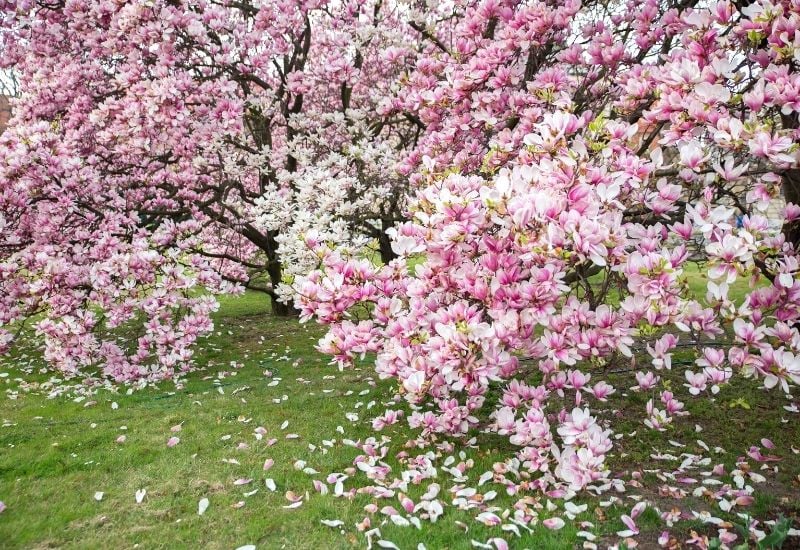
Magnolias are elegant and showy flowering plant species with many varieties and species that we associate with warm climate, like in the Southern states but deciduous varieties can be grown in almost any region of the U.S.
The fragrance of their blooms is loved worldwide: magnolia flowers look like tropical cupped bonfires in white, cream and even purple or red. And the rubbery and glossy elliptical leaves have a distinctive oriental and exotic look.
And did you know that some blossom in spring, some in summer and some even in winter? Of course, because there are so many species of magnolias…
Magnolia is a genus of 210 ancestral flowering evergreen or deciduous trees or shrubs. They can date back to 95 million years ago and they can have quite a range of sizes, flower color, blooming season, leaf size and even growing needs. Despite their exotic look, they are easy to care for, deer-resistant, and are generally free from disease.
With such an amazing selection of magnolias available, there’s at least one that will thrive just about every yard!
In this magnolia care guide first I’ll cover everything you need to know about planting, establishing, and tending magnolias in your garden, then I’ll share some of my favorite types of magnolia trees, suited for a variety of climates and spaces.
Ideal Growing Conditions For Magnolias
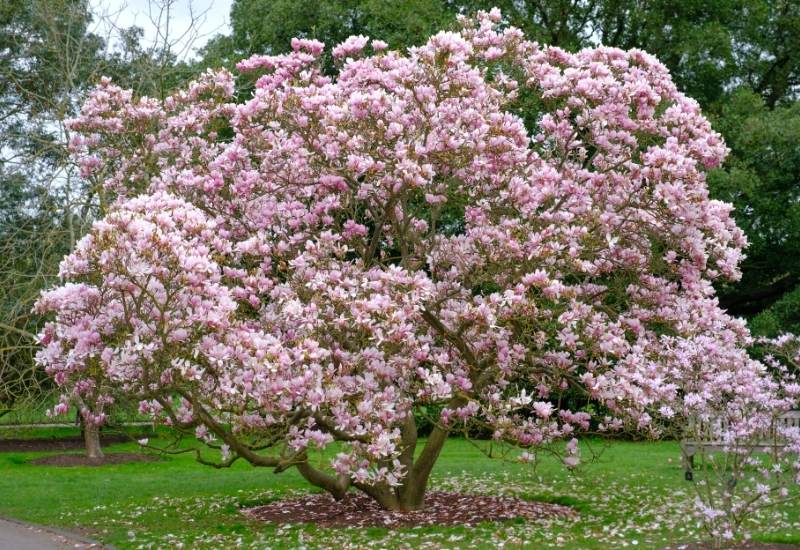
Regardless of your region, there is likely a magnolia that will grow where you live. Species within the genus are spread across a broad range of hardiness zones. Despite this broad range, many magnolias share common growing requirements.
USDA Hardiness Zones: 3-10
Sun/shade exposure: Full sun to part shade
Soil conditions:
Planting And Establishing Magnolias
Location is extremely important when planting magnolias. Two of the most important care tips for Magnolias relate to choosing a good place to plant them.
The reason you should follow these tips is related to the magnolia’s early spring blooms. When in areas of southern exposure, flowers can emerge prematurely in later winter. If a late frost occurs, it can damage the blooms.
Bloom protection is also the reason why magnolias need wind protection. Harsh winds can damage flowers and the foliage of species with larger leaves.
Proper location just that starting point but it plays a major role in the beauty and longevity of your magnolia.
After selecting a location, follow these magnolia planting tips.
Once planting is complete, there are a few measures you should take to ensure your magnolia established healthy growth in its new home.
Young magnolias need more water and fertilizer than mature magnolias.
When the time to begin fertilizing comes, use a 10-10-10 or an organic holly tone fertilizer. apply fertilizer at evenly spaced increments throughout the growing season. Continue this practice for the first three to four years.
Long-Term Magnolia Care
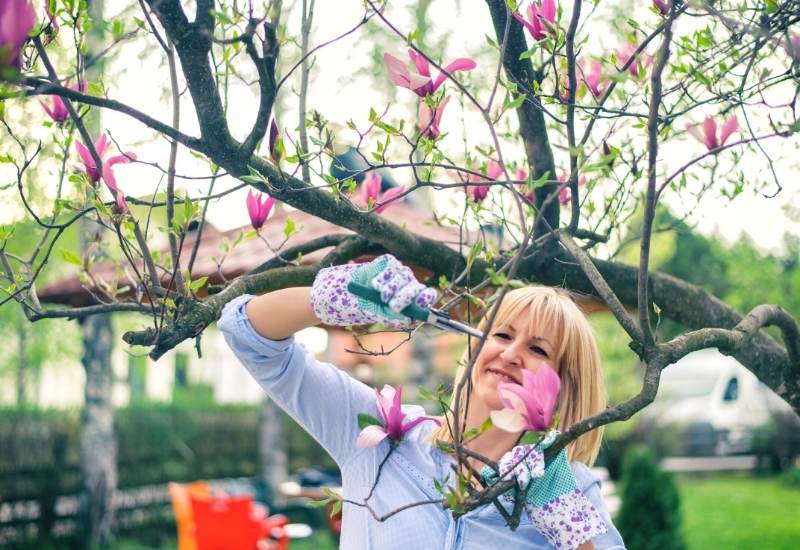
Established magnolias have different care requirements. Here is how you should adjust your magnolia care when you have a mature plant.
Pruning large branches is usually detrimental to the tree’s health. Magnolias have a poor ability to heal large pruning cuts.
Insects And Diseases
Many magnolias live out their lifespans with little to no disease or insect problems. But sometimes, problems are possible.
The most damaging issue for magnolias is magnolia scale. These insects are difficult to detect early on and can lead to mold development on the leaves.
Some other threats to magnolias include the following.
For issues involving insect infestation, you can introduce a predatory insect to eliminate the pest. Ladybugs, for example, will feed on some insects that afflict your plant.
When growing in consistently wet soil, fungal infections can develop as well.
In most cases, prevention is your best method for avoiding these problems. Follow the care instruction provided here to give your magnolia the best chance to live a long healthy life.
Transplanting
It is difficult to transplant magnolias due to the nature of their root systems. These roots are shallow and wide-spreading. They are also sensitive to damage.
This adds to the importance of selecting a good location for your magnolia from the start. If you choose to transplant you risk disturbing the roots to a fatal degree.
If, for whatever reason, you must transplant your magnolia, do so with caution. Follow these tips to give your magnolia the best chance to survive the transplanting process.
Remember that even if you follow these steps, there is still a chance that your magnolia won’t survive. Even if it does, flowers may not appear for a few years.
20 Stunning Types of Magnolia Trees You’ll Fall in Love With
We have established a general guide to caring for magnolias. Now it is time to increase your familiarity with individual magnolia species. This list will introduce you to 20 of the best magnolia varieties.
For each plant, you will learn more about any unique growing requirements, which will help you to better understanding of which magnolias will grow in your part of the world.
Read on to equip yourself with this knowledge and discover which magnolia tree you prefer most.
1. Southern magnolia (Magnolia grandiflora)
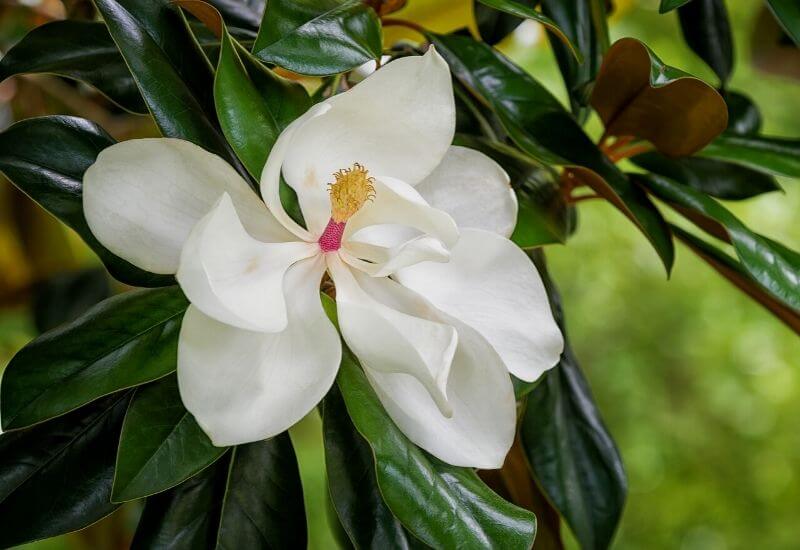
Southern magnolia is a large evergreen magnolia variety. Growing to 80’ in height an maturity, this tree is well-known throughout the south.
The flowers on this tree are creamy-white with six large petals. They bloom in spring but at times they can continue to bloom throughout the summer.
After the flowers die back, cone-shaped seed clusters replace them. Each individual seed is attached via a thread-like structure.
The leaves are large as well measuring about ten inches in length. Their shape is simple and oblong. Their color is dark glossy green.
This magnolia is not the best for regions with cold winters. But in some cases, it can survive to zone 6. Be sure to provide wind protection when planting this tree in northern regions.
Southern magnolia can survive in soil that is somewhat moist but this is not ideal. This tree also tolerates limited shade such as three hours per day.
2. Cucumber magnolia (Magnolia acuminata)
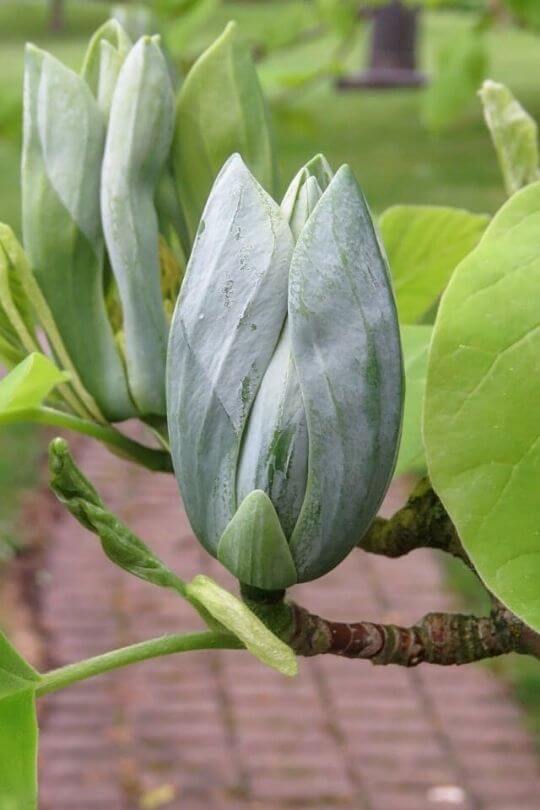
Cucumber magnolia is a deciduous magnolia with a pyramidal form. This form becomes more rounded as the tree reaches its mature height of 70 feet.
This magnolia tolerates soils that have a medium to high moisture content. In its native range in the Eastern United States, it grows along rivers and in woodlands.
While it can survive in moist soils, both extreme wetness and extreme dryness are a threat to this magnolia’s longevity. Avoid planting this tree in areas of pollution as it will not survive these conditions.
The flowers are greenish-yellow. However, there are many cultivars with differing bloom shades.
The leaves are dark green on top and light green on the bottom. They are deciduous with small soft hairs.
Many cucumber magnolias feature a single straight trunk. These trees are also suitable for colder climates.
3. Bigleaf magnolia (Magnolia macrophylla)

Bigleaf magnolia has the largest simple leaves of any tree native to North America. They are deciduous and can be up to 30 inches long.
The flowers are large as well. Their color is primarily white with purple at the base of each petal.
The fruits that follow the flowers are red and egg-shaped. They mature in late summer.
Since the flowers and fruits appear so high up on this tall tree, they can be hard to see.
Plant bigleaf magnolia in moist acidic soils away from any pollution. Provide protection as well as strong winds can tear the large leaves.
4. Star magnolia (Magnolia stellata)
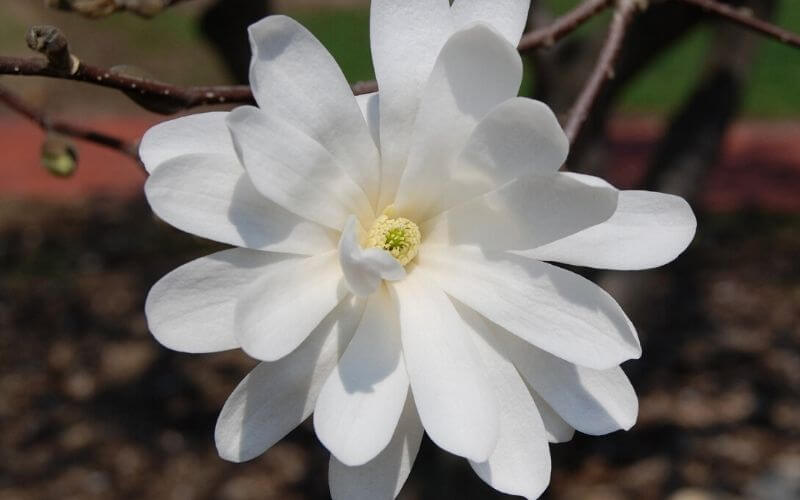
Star magnolia is a small tree native to Japan. It features white flowers that appear in March. They are star-shaped with about a four-inch diameter.
This tree is deciduous, and the flowers appear before the leaves. The leaves are on the smaller side with a simple tapered shape.
This is another magnolia that is intolerant of soil extremes and pollution.
When planting this tree, avoid direct southern sun exposure. At times, this kind of sun exposure can cause star magnolia to bloom too early. They may then freeze and die before the true spring season arrives.
5. Yulan magnolia (Magnolia denudata)
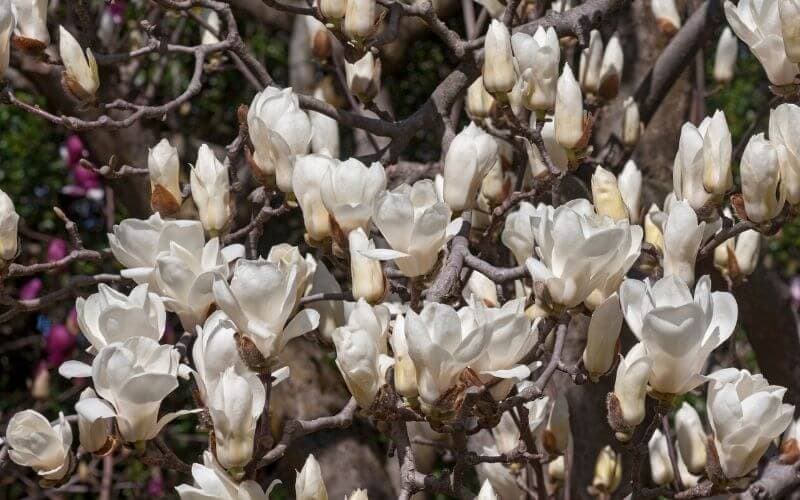
This mid-sized deciduous tree is native to China. It has a broad pyramidal shape and sometimes grows as a shrub.
The white flowers bloom in early spring. The petals appear in sets of ten to 12. They are smooth and curled forming a bowl-like shape.
This is not the best option for colder climates. Late winter frosts are known to damage the flowers of yulan magnolia.
You will also need to be patient when planting this tree as it can take around half a decade for the first flowers to bloom.
6. Cylindrical magnolia (Magnolia cylindrica)
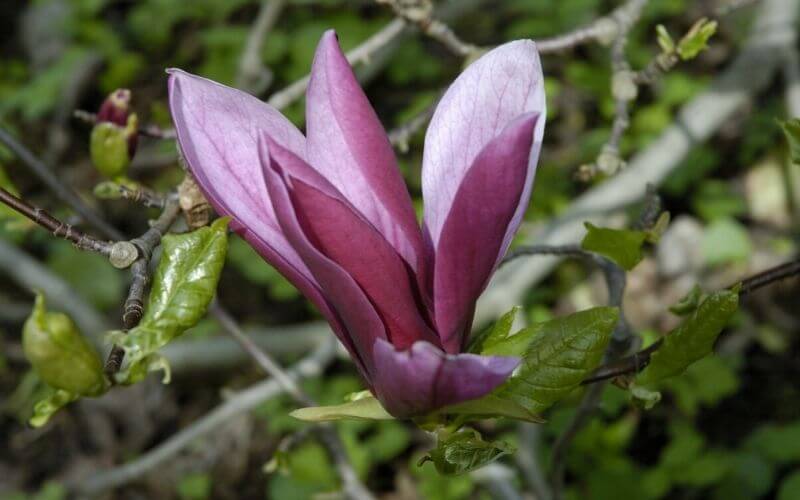
Cylindrical magnolia has a narrow vase-like form that reaches 30 feet tall. It is native to China and blooms in April and May.
When it blooms, the flowers have nine large petals that take on a three-pointed shape. Throughout the growing season, the white color fades to pink on some parts of the petals.
Provide a healthy layer of mulch to maintain a consistent soil moisture. Avoid southern exposure to avoid premature blooms that will die in a late-season frost.
Heat can be a problem as well. Strong direct sunlight in warm regions can scorch these deciduous leaves.
In keeping with the common name, the fruits have a cylindrical shape. They are around 5” long and are dark green. When they first emerge after the flowers, they have a bronze tint.
7. Sweet bay magnolia (Magnolia virginiana)
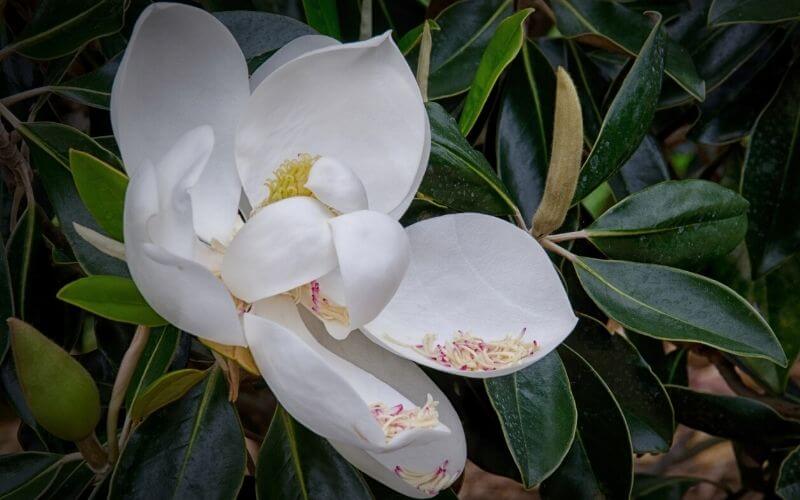
Sweet bay magnolia is a medium-sized tree native to the majority of the eastern seaboard.
As you might expect, this broad native range means that sweet bay magnolia grows in many hardiness zones. However, winters in northern regions can have a negative effect on the health of this tree.
This is one of few magnolias that grows well in soils that are truly wet, as opposed to just moist. Their liking for wet soils makes sweet bay magnolias perfect for rain gardens.
Sweet bay magnolia flowers bloom in the middle of spring. They are fragrant but less numerous and showy than the flowers of other magnolias. Each flower has nine or more petals and is about two inches across.
The leaves on this tree are evergreen and shiny. They are long and simple with an appearance similar to rhododendron leaves.
8. Umbrella magnolia (Magnolia tripetala)
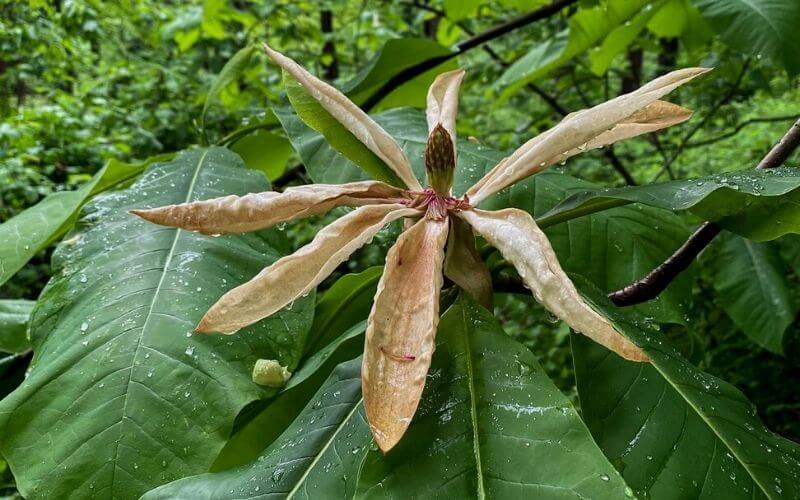
In rare cases, umbrella magnolia grows past 40 feet in total height. More frequently, it remains a small to mid-sized tree.
The common name for this magnolia is a reference to its leaves. This foliage shares a resemblance with foliage found on bigleaf magnolia.
Each leaf is deciduous and large, sometimes having a length of nearly two feet. They grow in groups at the ends of each branch where they sometimes look like miniature umbrellas.
The flowers are large as well with a cream color. They bloom after the leaves appear and can have an unpleasant smell. Each flower has up to 12 tepals arranges circularly with a diameter around nine inches or more.
Plant umbrella magnolia in part shade. Ensure an even soil moisture throughout the growing season.
9. Wilson’s magnolia (Magnolia wilsonii)
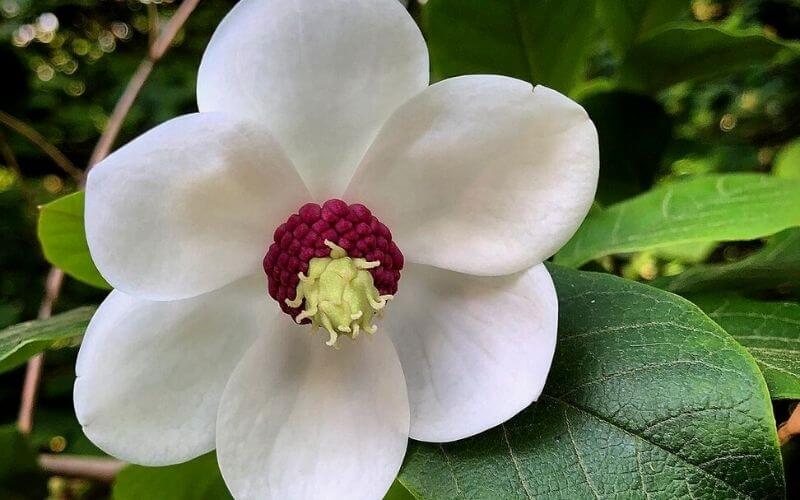
Wilson’s magnolia blooms in May with drooping cup-shaped flowers. The petals are white and surround a dark purple stamen.
With a native range in southern China, this magnolia grows best in warmer climates. However, in regions with excessive summer heat, part shade locations are ideal.
Wilson’s magnolia has a vase-like form. It can grow as a large shrub or as a small tree. Overall, this magnolia is easy to care for. It presents little to no problems related to disease or pests.
Provide slightly acidic soil that is consistently moist to give Wilson’s magnolia the greatest opportunity to thrive.
10. Anise magnolia (Magnolia salicifolia)
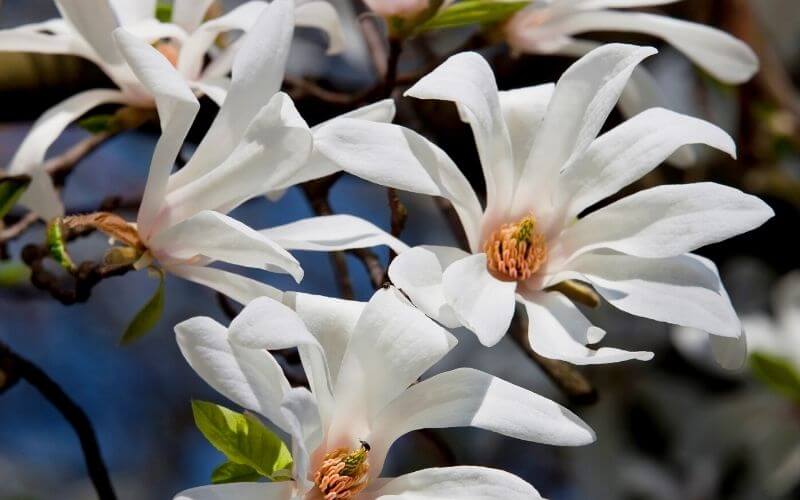
Anise magnolia is native to Japan and has a pyramidal mature form. This shape develops from a narrower upright form in youth. The maximum height for this tree is around 50 feet.
The blooms of this magnolia appear in early spring and can have a scent similar to lemon. The petals are white with curling edges.
These flowers emerge just before the foliage which is narrow and willow-like in shape. The leaves are deciduous and share the same scent as does the bark when broken or scraped.
It is best to plant anise magnolia in part shade and well-drained acidic soils. Prune in summer when the leaves are present.
11. Lily magnolia (Magnolia liliiflora ‘Nigra’)
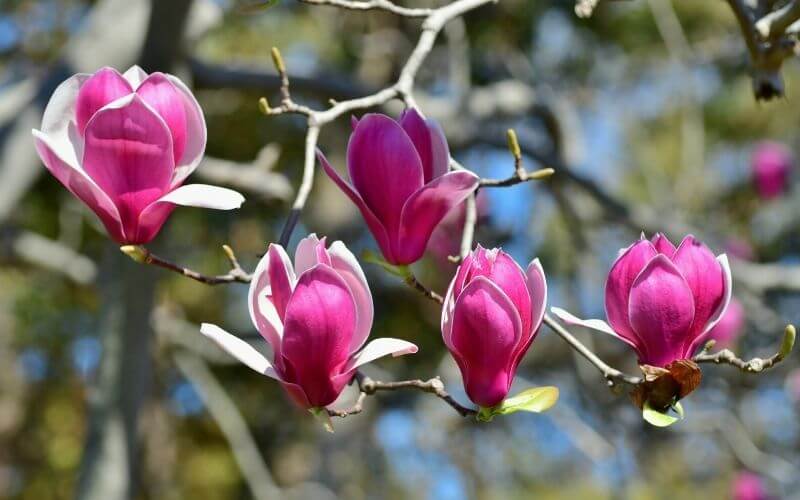
Lily magnolia has given rise to many cultivars and numerous famous hybrids as well. The ‘Nigra’ variety is one of the most attractive of these cultivars.
Most lily magnolias are small trees or rounded shrubs. The form of ‘Nigra’ is often more compact with larger flowers appearing later in the season.
These flowers have six to nine tepals all of which are five inches long. Their color is purple on the exterior portion, and light purple on the inside.
A cone-shaped fruit follows these flowers after they die back.
The foliage consists of dark green obovate leaves with a tapered base. These leaves are deciduous and can develop mildew problems. This is especially true in the late summer. Beyond that, lily magnolia presents few problems related to care and maintenance.
12. Saucer magnolia (Magnolia × soulangeana)
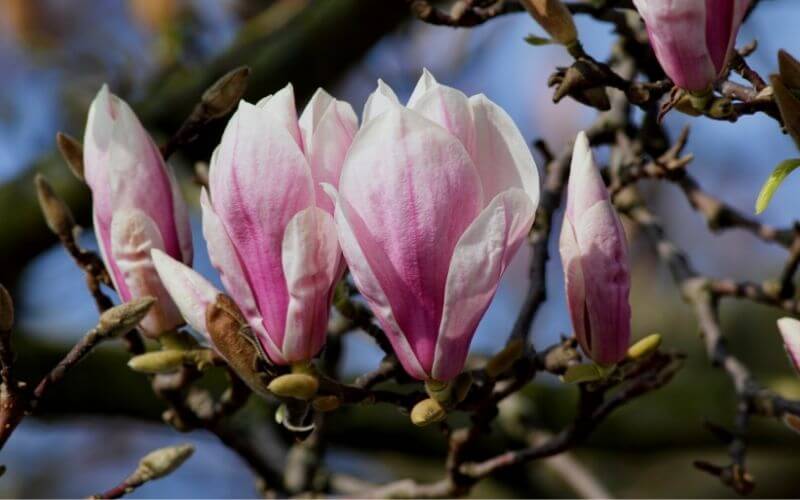
Of all deciduous magnolias, saucer magnolia is one of the most popular. This plant grows as a wide-spreading small tree. It is often multi-stemmed as well.
Saucer magnolia leaves are simple and twice as long as they are wide. Each leaf tip ends in a sharply pointed shape.
This tree is a hybrid magnolia resulting from a cross between Magnolia liliflora and Magnolia denudata. The eight-inch flowers have an astounding blend of white and pink. Related hybrid cultivars offer a wider variety of bloom colors.
Flowers bloom in March but this tree can show subsequent blooms throughout the growing season. However, these secondary flowers are often less rich in coloration.
Provide acidic soils with consistent moisture. Winter wind protection is a necessity as well.
13. Loebner magnolia (Magnolia × loebneri ‘Merrill’)
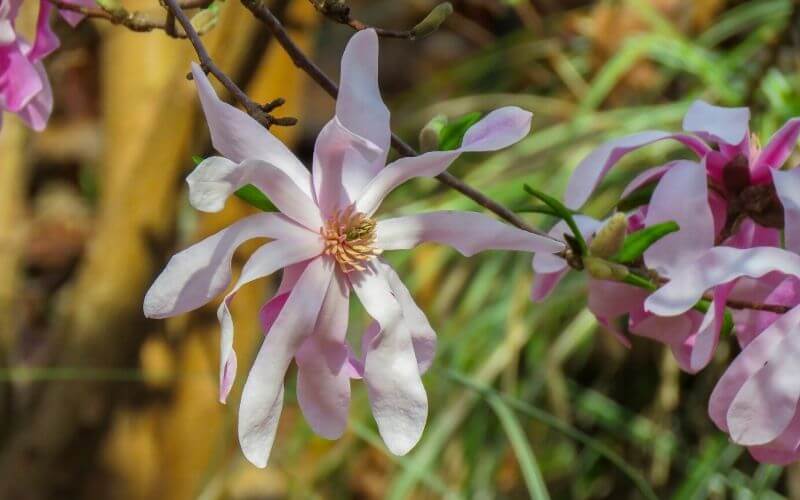
Loebner magnolia offers white star-shaped flowers in March and April. Each bloom has ten to 15 petals and is about five inches wide.
With flowers like that, it is little surprise that this hybrid results from star magnolia. Its other parent is Magnolia kobus.
Loebner magnolia is often multi-stemmed but it can grow as a small tree with a single trunk as well. The leaves are deciduous, simple, and have an oval shape.
When planting this tree, avoid any areas of urban pollution. Frost can be a threat to early blooms. To minimize that risk, consider the variety called ‘Merrill’ which can have better winter hardiness.
14. Oyama magnolia (Magnolia sieboldii)
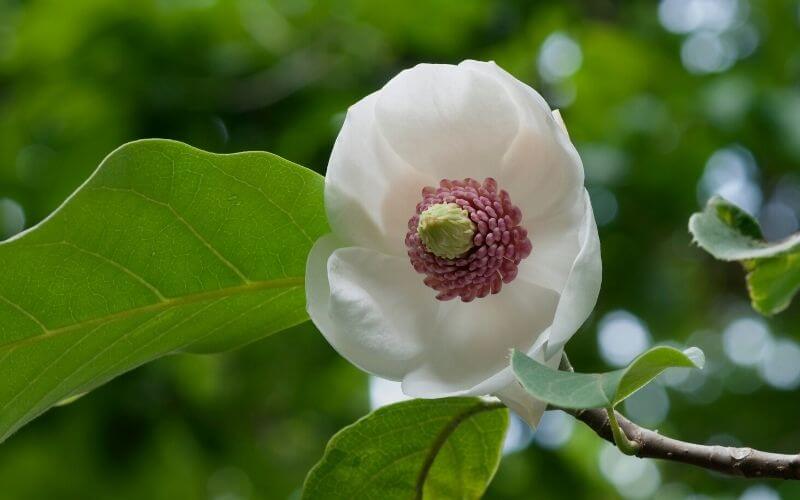
The flowers of Oyama magnolia are relatively unique among the many magnolia varieties. They are two-toned, with white petals and a dark red stamen.
When in bloom, these flowers are cup-shaped and point out at a horizontal angle. At times, they droop slightly downward. They appear later in the season than other magnolia flowers.
Overall, Oyama magnolia is vase-shaped. Its deciduous leaves create a rough textured appearance. In many cases, this plant grows as a shrub rather than a tree. Even in its tree form, it remains small at only 15 feet in maximum height.
In extreme heat, leaf scorch is possible. Also, unlike many other magnolias, Oyama magnolia is not tolerant of poor soil conditions.
15. Kobus magnolia (Magnolia kobus)
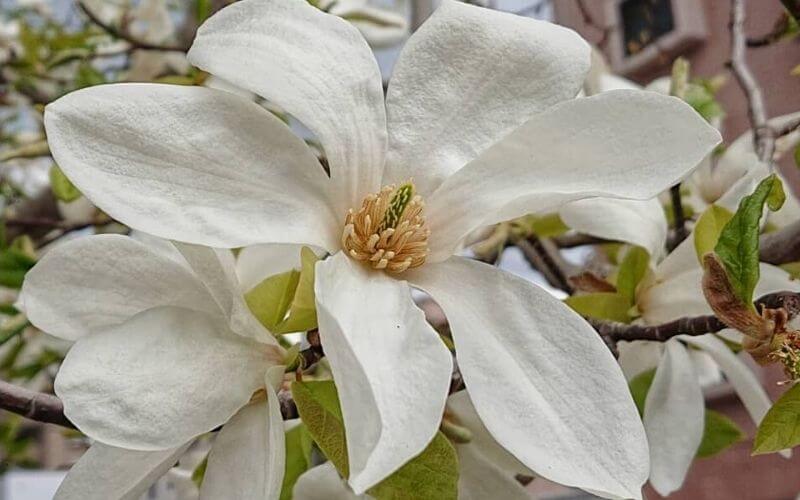
Kobus magnolia is a medium-sized tree with a wide-spreading form at maturity. This tree is native to Japan where it is likely to grow in woodland settings.
The common name is based on the Japanese word for fist. Inspiration for this name comes from the shape of the flower buds prior to blooming.
When in bloom, the flowers are goblet-shaped and about four inches across. The petals come in groups of six to nine and are white with a subtle pink or purple line at the base.
The leaves are deciduous with a simple rounded shape. They have a dark green color and a strong scent.
This magnolia is one of the first to bloom in the early spring. However, it takes many years for flowers to develop. At times it will take up to 30 years for the first blooms to appear.
16. Zen magnolia (Magnolia zenii)
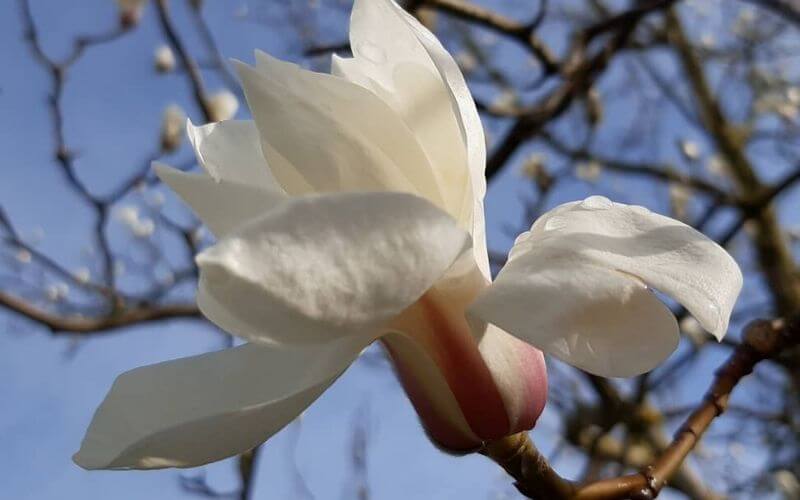
Zen magnolia is a deciduous tree native to China. Although it is becoming less common in its natural range, its ornamental qualities remain.
This magnolia blooms very early in the spring. It normally blooms in March, but in many cases, the flowers can emerge in February or even late January.
The tepals are white with significant fuchsia markings starting at the base and streaking to the tip. About halfway up, the tepals begin to bend outward away from the center of the flower.
The leaves are pleasing as well. They have a simple elliptical shape and are dark green. The surface of this foliage features an undulating characteristic and a glossy texture.
Zen magnolia grows best in soils high in organic matter. However, it can also survive in sand and clay soils. This tree also prefers more sunlight than other magnolias. Six or more hours per day is ideal. Because of its incredibly early flowering, wind protection is especially important in colder regions.
17. Sprenger’s magnolia (Magnolia sprengeri ‘Diva’)
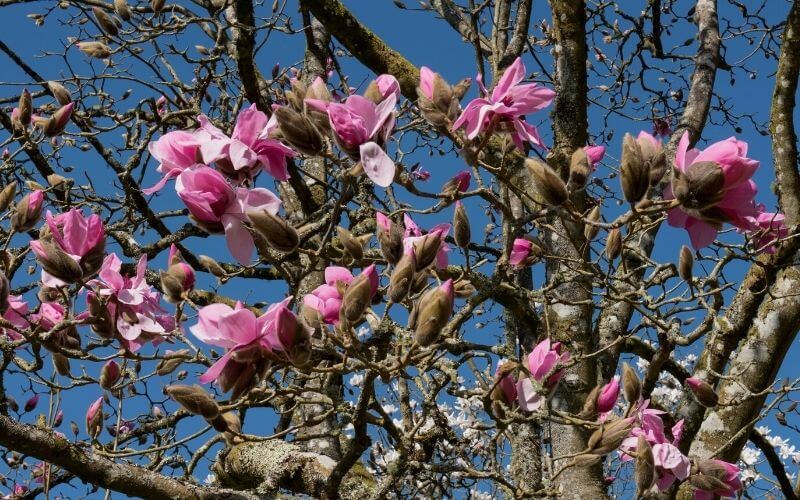
Sprenger’s magnolia is a medium to large tree with a rounded form. At its maximum, it can reach 50 feet tall. However, it is more likely for this tree to remain closer to 30’ in total height.
The flowers of this magnolia are magnificent in shape and color. The petals are a soft pink color and they tend to have a graceful inward curve. They form a cup shape around a pink textured stamen.
The flowers appear in high numbers early in the tree’s life. They also bloom slightly later in the spring. This gives them a better ability to avoid damage from late-season frosts.
Sprenger’s magnolia tolerates both acidic and slightly alkaline soils. It is also attractive to pollinators including both birds and butterflies.
Prune this tree when the leaves are present in mid-summer. Also, look out for problems like root rot, fungus, and magnolia scale.
The Little Girl Hybrid Magnolias
While there are many hybrid magnolias, there is one hybrid group that proves to be more popular than any other. The Little Girl hybrids are a group of deciduous magnolias with a variety of flower colors. Horticulturalists developed this group to bloom later in the season.
Their goal in this was to create magnolias that were less likely to have their flowers damaged by late-season frosts. Below are three of the most common magnolia varieties in this hybrid group.
18. Ann magnolia (Magnolia ‘Ann’)
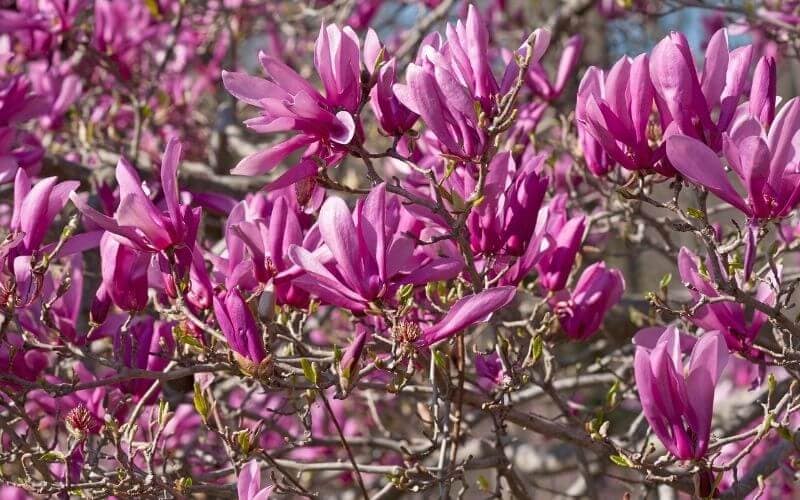
Ann magnolia is a cross between Magnolia liliflora ‘Nigra’ and Magnolia stellata ‘Rosea’. It is a small tree with an open growth habit.
This magnolia blooms from April to May. Its flowers are mostly a deep purple color. Each flower has seven to nine petals.
Ann magnolia has an especially sensitive root system making transplanting difficult. However, pruning requirements are quite minimal. Simply removing dead branches is sufficient.
Plant in medium moisture soils that are neutral or slightly acidic. Mulch over the root zone will help to maintain the proper soil moisture level.
19. Betty magnolia (Magnolia ‘Betty’)
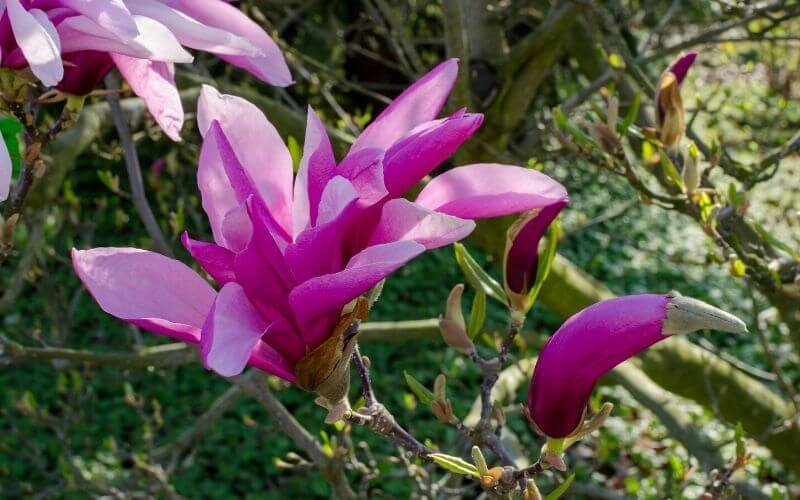
Like Ann magnolia, Betty magnolia is also a cross between Magnolia liliflora ‘Nigra’ and Magnolia stellata ‘Rosea’. But the results of this cross are slightly different.
Betty is a larger plant growing to 15 feet. Its flowers have a two-toned characteristic. These blooms are purple, or sometimes nearly red, on the exterior. Inside, these petals are white or a washed-out pink.
The leaves are bronze in both fall and mid-spring when they first emerge. In the summer, they develop a more traditional green color.
This magnolia type is slow-growing but presents very few maintenance and pest problems.
20. Susan magnolia (Magnolia ‘Susan’)
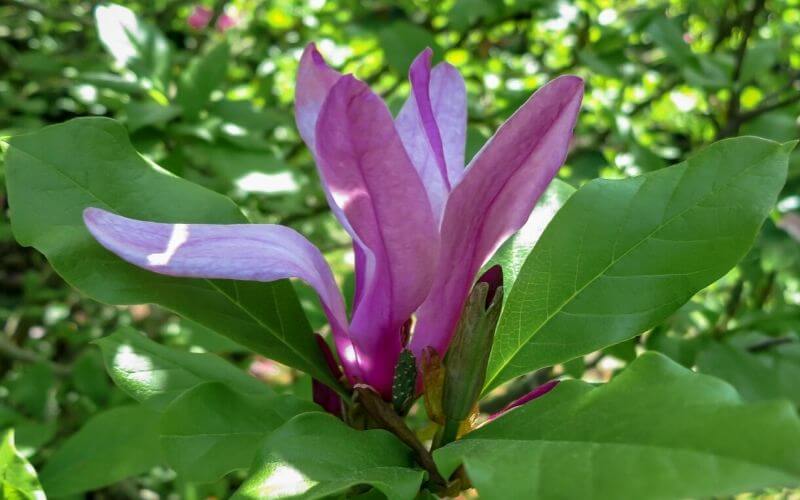
Another cross between Magnolia liliflora ‘Nigra’ and Magnolia stellata ‘Rosea’, Susan magnolia is slightly more hardy than other Little Girl magnolias.
Susan magnolia has deep purple flowers with a slight reddish hue. This color is consistent across the entirety of each petal.
The buds emerge with a long narrow shape. When they open, the tepals are slightly twisted. Of all Little Girl magnolias, Susan magnolia has the largest flowers.
Plant in acidic or neutral soils in full sun or part shade. Other than some susceptibility to mildew, this magnolia is usually problem-free.
Conclusion
Magnolias are a magnificent addition to any garden. They are an especially great option for those who love early-season blooms. But as you now know, the appeal of magnolia trees goes far beyond the flowers alone.
You also have some knowledge about how to select and care for different magnolia varieties. By knowing the general magnolia growth requirements, as well as the needs of individual species, you can add these lovely flowering trees to your yard.

Written By
Margie Fetchik
Margie and Arkansas native has an extensive background in gardening and landscaping. For the last 40 years, Margie has called the Colorado Rocky Mountains her home. Here she and her husband of 36 years raised three kids and owned a successful landscaping company. Margie has a CSU Master Gardener certification. She specialized in garden design & installation, perennial gardens, turf grasses & weeds, flower containers, and the overall maintenance of allHOA, commercial and residential accounts. She and her husband now reside in Denver and are excited about the new experiences’ city life holds.
